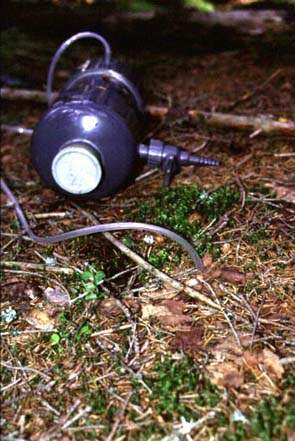Aims
- give data on nutrient conditions and possible toxicity in the
soil of relevance to plant roots, fungi, soil fauna and microbes
- give data on the transport of nutrients, acidifying substances
and metals in relation to the water flow
- establish mass balances of pollutants and other substances in
the soil fluid
The soil water is intimately coupled to the chemical and biological
processes in the upper soil layers and a sensitive indicator of
both acidification and eutrofication. It is essential to follow
its composition in order to understand the interplay between soil
hydrology and the biological processes on both plot and catchment
level.
Soil water is sucked by ceramic bodies in so-called vacuum lysimeters.
They are placed in the bleached E layer just below the humus layer
and in the B horizon. Three to six ceramic tension lysimeters
at each soil depth are installed at one or two places in the catchment.
It is difficult to extract available soil water in an indisputable
way, but whatever you get adds important information on the situation.
Soil water is collected every second month during the frost-free
part of the year – if available.
Variables
- normal year: pH, conductivity, Na, K, Ca, Mg, Al, Mn, Fe, NH4, NO3, SO4, Cl, HCO3, total N and total C
- campaign year additionally: Cu, Zn, Pb, Cd, Hg and labile Al
|



